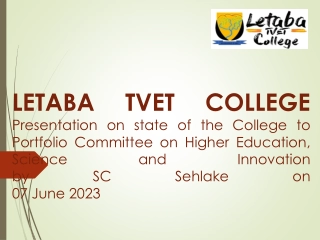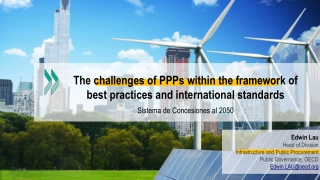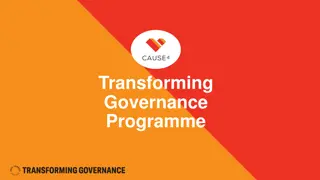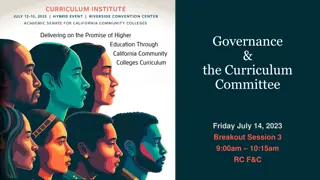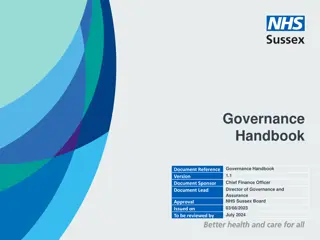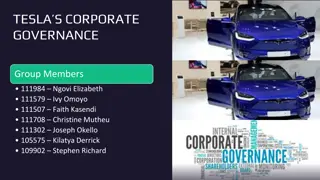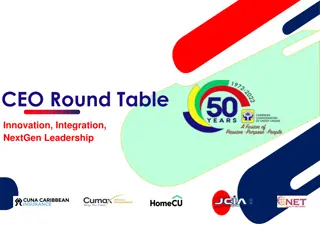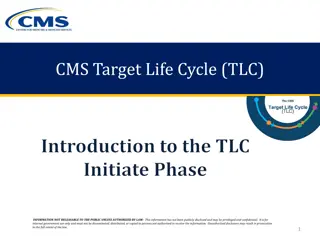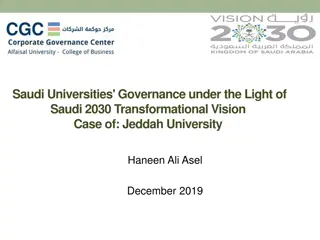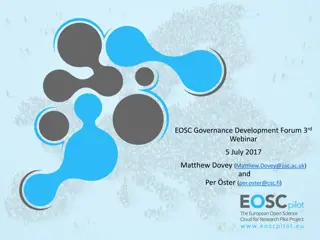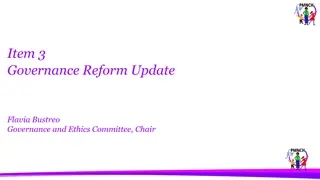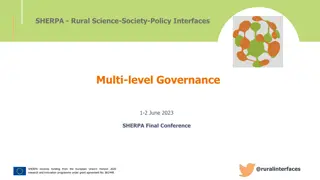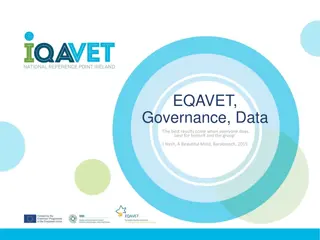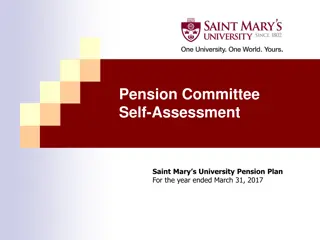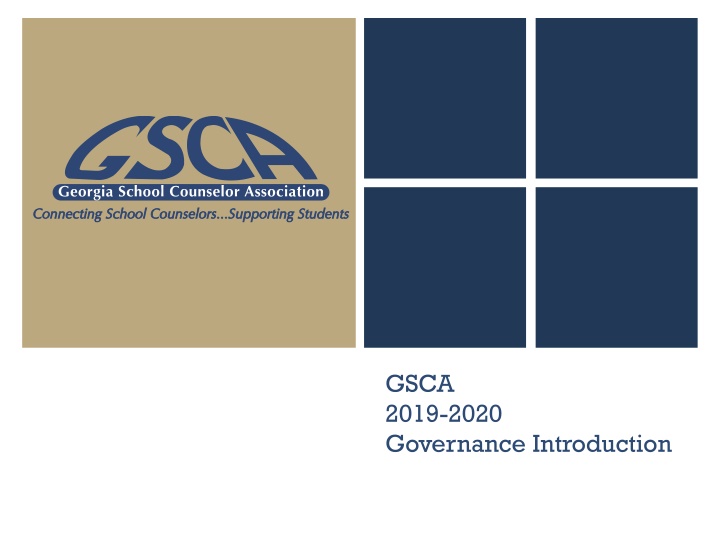
Association Governance and Principles - GSCA Overview
Delve into governance and principles of the Georgia School Counselor Association (GSCA), focusing on the unique essence of associations, their legal framework, and core guiding beliefs. Explore the roles of governing bodies in achieving the GSCA's mission and supporting school counselors for student success.
Download Presentation

Please find below an Image/Link to download the presentation.
The content on the website is provided AS IS for your information and personal use only. It may not be sold, licensed, or shared on other websites without obtaining consent from the author. If you encounter any issues during the download, it is possible that the publisher has removed the file from their server.
You are allowed to download the files provided on this website for personal or commercial use, subject to the condition that they are used lawfully. All files are the property of their respective owners.
The content on the website is provided AS IS for your information and personal use only. It may not be sold, licensed, or shared on other websites without obtaining consent from the author.
E N D
Presentation Transcript
GSCA 2019-2020 Governance Introduction
+ Who Are We?
+What is An Association? IRS Definition: a group of persons banded together for a specific purpose ASAE (American Society of Association Executives) Definition: A sense of community coordination is at the heart of the association profession. People voluntarily join associations because they want to work together on a common cause or interest today s associations still share the purpose of coming together to produce positive results The Will to Govern Well: Associations are unique because they are like a triple-helix DNA composed of three intertwined threads- members as owners, members as customers, and members as workforce Associations owners, customers, and workforce are one and the same. Key competitive advantages associations have in the 21stcentury- the aggregate intellectual capital of their membership, their energy as a community with common purpose, and their credibility as a voluntary institution Summary: a group of people who voluntarily come together to solve common problems, meet common needs, and accomplish common goals Associations are unique because of their commonness, voluntary nature, goals and people
+What is An Association? GSCA is a 501(c)(3) nonprofit corporation governed by Georgia corporate law Note: this does not mean we are exempt from sales tax; we simply are exempt from income tax for activities that fall within the scope of the mission
+Who We Are: Guiding Principles New Mission Statement Approved November 2017: The Georgia School Counselor Association supports school counselors in Georgia as they promote student success.
+Who We Are: Guiding Principles Belief Statements As members of GSCA, we believe: all students, grades K 12, deserve access to school counseling services the nature and substance of school counseling programs should be comprehensive, developmental, and continuous on-going enhancement of school counseling skills and knowledge to benefit children is essential. all people have value and deserve respect and dignity counseling services provided to students and schools should be data driven with appropriate accountability components all students should be taught skills that lead to developing competencies in the three areas of academic, career, and social.
+ Who Are We: Governing Bodies Membership Assembly Highest legislative body Approves some dues increases, changes to Bylaws, etc. Assigns governing responsibility to the Executive Board Membership Assembly Executive Board The Executive Board is responsible for making decisions and conducting the business affairs of the Association on a daily basis Responsible for strategic planning and oversight Executive Board Leadership Team Perform tasks as directed by the Executive Board or as outlined in the Organizational Handbook Difference between Committees and Membership Sections Leadership Team
+ Governance
+Best Practices: Keys to Successful Associations A Reputation for Value: we do good stuff An Enjoyable Culture: based on trust and communication Clarity and consensus about what will constitute success (hint: this is why you do a plan of action) Open access to common information Confidence in the competence and commitment of your partners A Nimble Infrastructure: allows associations to seize opportunities to create value, doing work in the right way in the right amount of time These are key for maintaining relevance and assuring long term success
+Hierarchy of Documents These establish the legal status of organizational documents: Articles of Incorporation: an agreement between the association and the state defining the organization s legal purpose and its tax-exempt status; establishes the legal basis for the organization s existence. Bylaws: an agreement between an association and its members, defining who can participate in the association and how they participate. Member eligibility and classes, officers and standing committees are key provisions found in the bylaws; it is second in the hierarchy. Policies: these set parameters or specific mandates for action and decision making. Board minutes: these are an account of the decisions, actions and policies that come from a meeting Procedures: step-by-step processes detailing how to accomplish tasks in the organization. Procedures are operational in nature and not considered governing documents. Practices: ways in which organizations do things that are not documented in policies and procedures.
+Bylaws 101 Remember, Bylaws are our agreement between an association and its members Key provisions: Mission Types of and eligibility for membership Professional Student Retired Affiliate Honorary Power regarding changes in dues (up to a 20% change is decided by the EC, over 20% goes to Membership Assembly for approval) Membership cycle (expiration: June 30 annually) Voting rights Function and composition of all governing bodies, including Membership Assembly; duties of members Nominations and Elections provisions Rules regarding amendment of the Bylaws
+Org Handbook101 Remember, the Organizational Handbook is our policies. These set parameters or specific mandates for action and decision making. These are much more in depth than the Bylaws. They can be revised by the Executive Committee as needed. Key policies: Membership additional policies surrounding: Types of membership Dues structure Rights and privileges Severance of membership Regions (including region map by county) Fiduciary responsibility Financial policies Records retention Conflict of interest Whistleblower Endorsement policy Privacy guidelines Nominations and elections procedures Professional recognition Scholarships Policy for memorials/honorariums Publications (policies regarding the Journal, Beacon and Counselor Connection) Website content policy Conference & LDI policies Leader job descriptions
+Knowledge-Based Decision Making: Four Key Questions Question 1: What do we know about our members, prospective members, and/or other stakeholders needs, wants and preferences that is relevant to this decision? Question 2: What do we know about the current realities and evolving dynamics of our profession that is relevant to this decision? Question 3: What do we know about the capacity (in terms of resources do we have the people, time and financial ability?) and strategic position of our organization that is relevant to this decision? Question 4: What are the ethical implications of our choices?
+ Leadership Role and Function
+Fiduciary Duties Duty of Care Leaders must use responsible care and good judgment in making their decisions on behalf of the interests of the whole organization Attendance: bound by board actions, even if you are absent Duty of Loyalty Faithful to the organization Avoid (and disclose potential) conflicts of interest Duty of Obedience Comply with the governing documents Act in ways that are consistent with mission and central goals of GSCA The board acts as a whole, not as individuals More information can be found on pages 7-8 of the Organizational Handbook
+Leader Responsibilities Governance Be accountable for execution of the mission Read and familiarize self with all governing documents (Bylaws and Organizational Handbook) Be accountable for following these documents Ensure legal and ethical integrity and maintain accountability Immediately disclose any potential conflicts of interest Keep confidentiality Be responsible for the financial health of the organization, including Being aware of financial status and acting in a fiscally responsible manner Do not spend (or commit) money without prior approval (i.e. unless it is budgeted and within the scope of your role) Do not sign contracts, agreements, etc. Understand your responsibilities/duties and commit to fulfill them Alert the President if you become unable to fulfill your responsibilities Promote GSCA s image Serve as a steward of the profession with the members and the public Never speak on behalf of GSCA (including to the press) without a direct request from the President Do not use GSCA logo, letterhead, etc. without authorization Operations Ensure all files you use to conduct your work are on file with the GSCA office
+Responsibilities By Role See job responsibilities in the Organizational Handbook It is critical for all leaders to have: Shared commitment to fulfilling the mission and vision Understanding of responsibilities/duties and commitment to fulfill them (or alert the President if you become unable to)
+Reporting Structure Area Supervisors: Professional Advancement (Myesha Davis) Advocacy, ASCA/RAMP, Career/Post Secondary, CKES, Professional Recognition, Service Project Publications (Laura Ross) Journal, Beacon, Social Media, Photographer, Archives Recruitment & Sustainability (Rebecca Burkhart & Beth Ruff) Graduate Student, PPAC, Retired, Coordinators, Educators, Elementary, Middle, Secondary, Rural, Region Outreach (Vance Sims & Donna Jones) Finance (Catherine Roberts) Conference (Maria Grovner)
+Possible Membership Section Activities Newsletter Guided discussion boards (online collaboration platform coming late 2019/early 2020) Blog (include members of your section to author ) Host a member recruitment campaign 30 minute podcast record, send to staff, we ll post to web site Webinars Virtual meetings Community service activities White papers or other resource generation
+ Financial Procedures and Budget
+Budget Budget draft is completed in February, discussed and approved by the Finance Committee, then discussed and approved by the Board Fiscal year: July 1 June 30 Individuals with budget authority: Conference Chairs Current = $3,000 Next Year = $1,500 President = $500 President-Elect = $250 Regions = $250/region Advocacy = $1,200 Grad Student Liaison = $100 Photography = $500 Professional Recognition = $1,500 (less $700 for professional recognition ceremony, planned in conjunction with Conference Manager) Trainings (CKES, ASCA) = $1,000 (net)
+Reimbursement Requests Steps to submit for reimbursement: Complete the Voucher form Attach mileage (if applicable) you must attach a Google Map/MapQuest showing the start and end addresses and miles travelled Attach/scan receipts (if applicable) www.gaschoolcounselor.org 1. 2. 3. Itemized receipt showing all items purchased; AND Final receipt showing method of payment 1. 2. All of these items must be included or vouchers will be returned Hint: all of these are clearly listed in the Voucher Checklist section of every voucher
+Reimbursement Requests GSCA Fiscal Year 2019-20 Voucher Payable to: Mailing Address: City: Requested by (if different): Email: Part 1: Mileage Reimbursement Date: State: Zip Code: Phone: Rate: $.35/mile Mileage: Total Mileage Reimbursement: $ - Please attach directions- including start and end address- when submitting Detailed Purpose/Reason for Travel: Date of Travel: Meeting Location (City): Part 2: Itemized Expenses Identify each expense below and attach corresponding receipt/invoice Description/ Reason for Expense Budget Area Amount $ - Total Itemized Expenses Part 3: Reimbursement Total Total Mileage (from Part 1- if applicable): Total Itemized Expenses (from Part 2 - if applicable): $ Total Reimbursement Amount: $ $ $ - - - Part 4: Voucher Checklist I have included both the original, itemized receipts/invoices and the receipt showing the method of payment (credit card, etc.) and have taped them to an 8.5 x 11 paper (multiple receipts per page acceptable. Do not tape over any information on receipts) For meal receipts, I have noted the name of each person whose meal is included on the receipt on the page next to the receipt For mileage reimbursement, I have included a map/directions (such as Google Maps or MapQuest print out) which clearly shows the start and end point and matches total mileage requested in part 1 Please note that checks may be held until all of these items are received.
+ Leadership Team and Staff: How do We Work Together?
+Members and Leaders Expectations of Staff Value and appreciate the profession of school counseling and its impact on society Be sufficiently familiar with the condition of the profession in order to clearly understand what is going on (note: staff judgments about what to do are never a substitute for the judgments of members) Have sufficient knowledge of the dynamics and direction of GSCA Give good counsel about conditions, challenges and opportunities and provide insightful advice on choices Adapted from Gabriel Eckert, CAE
+Staffs Expectations of Members and Leaders Agree to consider and value staff s insights, perspectives and counsel about conditions, challenges and opportunities for the association Be clear about outcomes desired and provide sufficient empowerment to senior staff to design and execute strategies required to achieve progress Understand that staff s role as an association management professional reflects a distinct and unique set of professional competencies and deserves the respect that the profession of school counseling receives Adapted from Gabriel Eckert, CAE
+Meet Your Staff Sarah Berke, CAE, Managing Director Main point of contact for Executive Board & President Oversight of governance and execution of strategic initiatives Oversight of all GSCA operations & staff Jessica Atkinson, Community Manager Web site management Marketing and communications planning/execution Membership management Conference registration management Primary liaison to leadership team Ellen Shea, CMP, Conference Manager Event management for the annual conference, including liaise with conference team Executes meeting planning and other conference management functions Michele Doyle, Association Assistant Main contact for member inquiries (email/phone support) Conference registration assistance Dues and membership follow up/assistance Administrative support Karen Lowe, CPA, Accountant Handles GSCA s financial needs, including bookkeeping and monthly reporting POC for GSCA s external CPA for tax prep and review
+Board vs. Staff The Board Governs, the Staff Manages Governance: Volunteer leaders are responsible for the direction and future of the organization. The board acts and thinks strategically, setting goals and strategies for the future with input from members, stakeholders and committees. The board continuously conducts an environmental scan. Leaders should maintain focus on mission, vision, values and goals. Management: Staff is responsible for the administration of the organization. Staff act as partners to the leadership, advancing the goals and strategies, while taking care of the daily administrative needs unique to non-profit organizations. The Board - Staff Pledge: The board and staff works together as a partnership to 1) add value, 2) make a difference and 3) protect the organization.
+ Responsible vs. Involved Area EB Responsible EB Involved Committee Chairs/ Section Liaisons Responsible Committee Chairs/ Section Liaisons Involved Staff Responsible Staff Involved Governance X X Administration X X Decides What X X X Decides How X X Makes Policy X X Carries Out Policy X X X Sets Goals X X X Plans to Achieve Goals X X X Reviews Plans X X Implements Plans X X Monitors Progress X X X Note: Chairs/Liaisons and Staff often share similar levels of responsibility/involvement. Extent of each depends on the program/area, level of contracted services, etc. Get with me with questions. Slide adapted from Gabriel Eckert, CAE
It's easy to make a buck.It's a lot tougher to make a difference. ~Tom Brokaw

